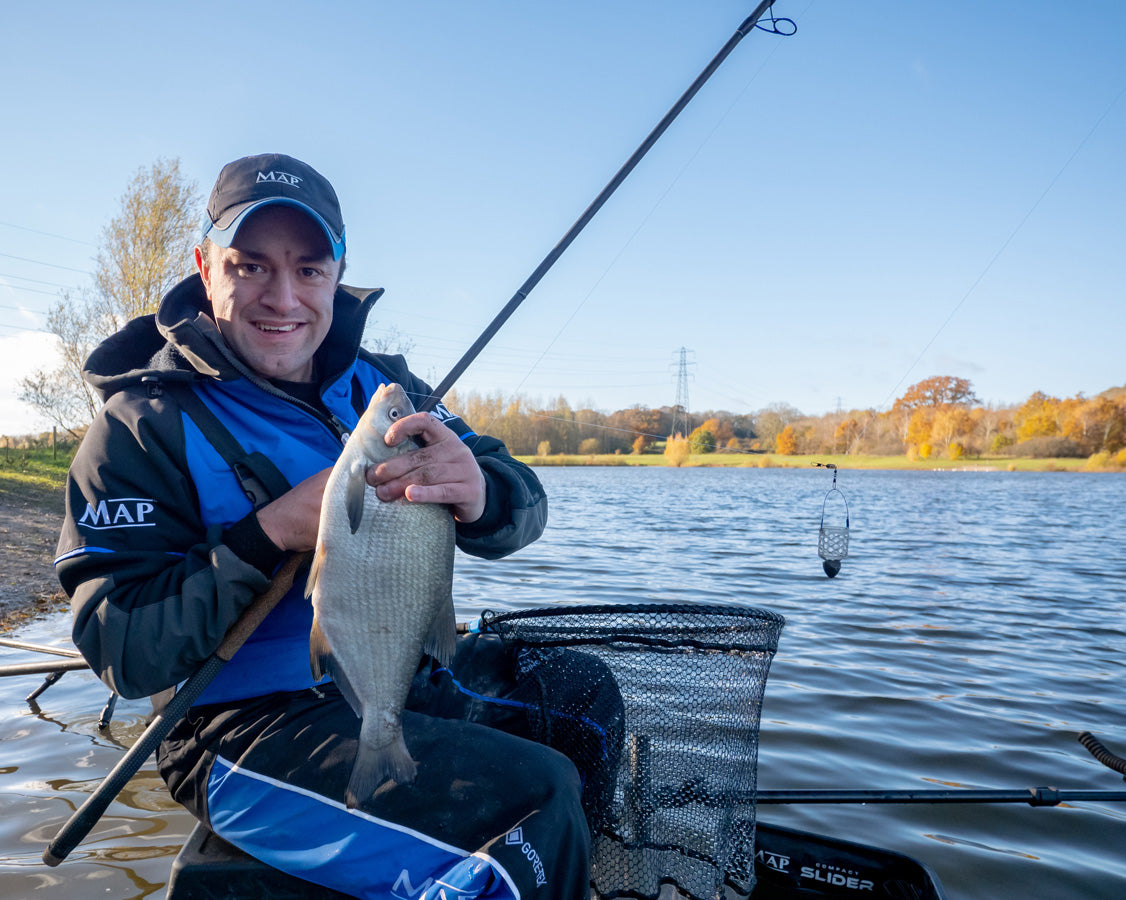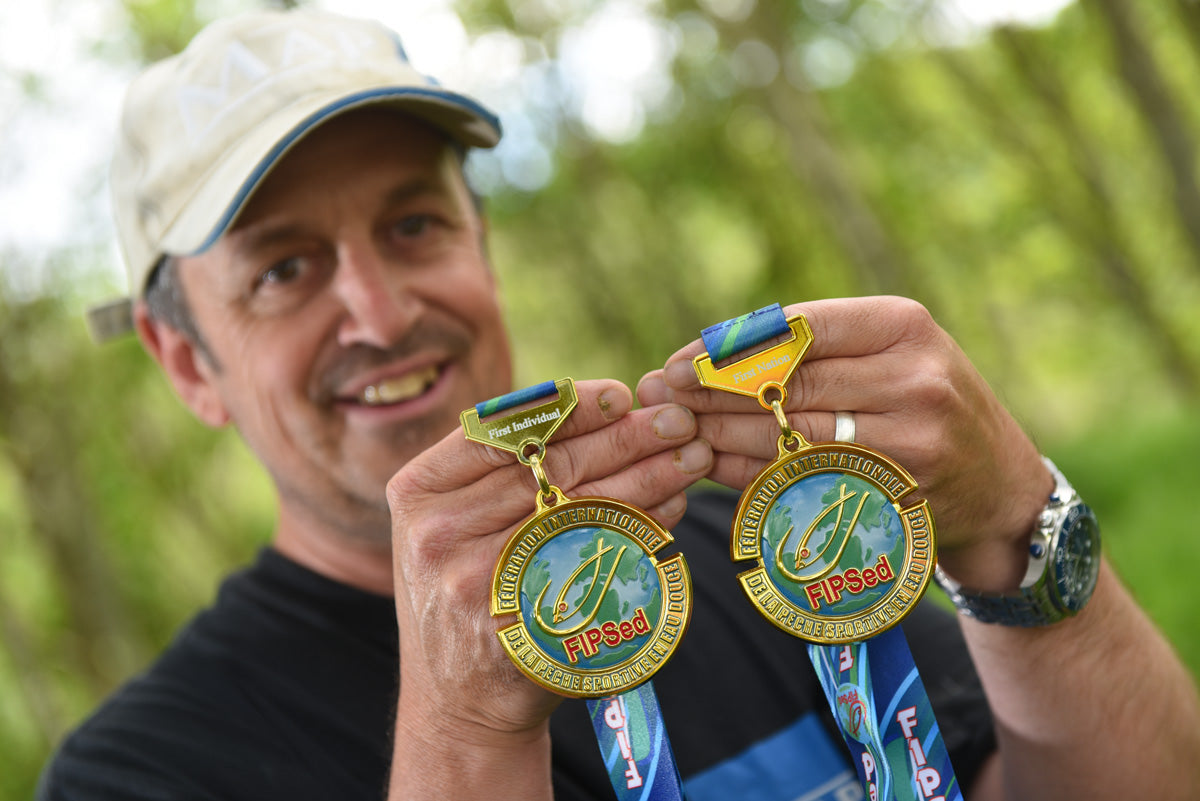Go The Distance!
When the cold sets in, fishing at distance on the feeder can be a big advantage according to Tony Curd. We joined him at Albans Lakes to find out more.
While it can be very productive at times, on the majority of venues the effectiveness of fishing a short feeder line is massively reduced during the colder months especially on big open expanses of water.
When the cold sets in, fishing at distance on the feeder can be a big advantage according to Tony Curd. We joined him at Albans Lakes to find out more.
While it can be very productive at times, on the majority of venues the effectiveness of fishing a short feeder line is massively reduced during the colder months especially on big open expanses of water.

With the water temperature low, and clarity at its greatest during the winter, fish will naturally feel safer sitting further away from the bank, coupled with the fact they tend to feed for shorter spells and move around a lot less during the colder months, it all leads to a distance-based approach.
One venue where this is the case more often than not is where you find me today, Albans Lakes in Hertfordshire. Full of big carp and bream, it’s an excellent venue all year round but is a popular match venue when the cold sets in.

With lots of open water to go at, and the majority of carp anglers feeding their bait at range making it easy for the fish to feed when they need to, the bigger fish tend to stay away from the bank.
The cold weather had really started to set in prior to our visit to the venue and with the carp catches slowing down, it’s time for the venues silver fish population to take centre stage!
Gear Up!
When tackling big open venues like this one, using the right kit for the job is all important. Not just to reach the desired distance, but also to counter the conditions should they change during the match.
We’ve all been there, fed our bait on a spot easily reached at the start only for the conditions to change and you then struggle to get out there as your kit is under gunned.

Today, I’m going to be fishing at 60 metres on a cage feeder and I’m also going to have an Embed feeder set up to fish just past my baited area so we’re not talking huge distances, but a good stretch away from the bank into the central area of the lake.
The rods I’m using today are from the new MAP Extremis range which will be available in early 2024 these offer incredible value for money and is a complete range with anything from 10ft rods right through to 4.2m distance rods so there’s something to cover all eventualities.

For the cage feeder, I’ve selected the 12ft Feeder fitted with a 1.5oz tip this is teamed up with a 5000 sized reel loaded with 0.12 Agitator AX8 braid, this is an important part of the set up in the cold as the bites can be hard to detect at long range with longer hook lengths using mono so if it’s allowed, I’ll always use braid.

To the braid I’ve got a shock leader of 10lb mono attached, the rig is a simple running rig down to a bead and a snap link to attach my 50cm hook length to.
The hook length is made up on 0.15mm MAP Optimum Power to a size 14 or size 12 B560 hook, I like to use heavier hook lengths at distance as it helps eliminate tangles plus it gives me a chance of landing any bonus carp I may hook too.

For the Embed feeder I’ve gone for the 3.9m Distance Feeder rod, again teamed up with a 5000 reel this time loaded with 8lb Optimum mono, and a 10lb leader again.
As we’re fishing with a shorter hook length and a positive set up on this for quality fish, bite detection isn’t an issue so braid isn’t needed.

The feeder is a 42g large in-line Embed feeder down to a 4-inch hook length of 0.19mm Optimum Power and a size 12 hook with a bayonet attached as wafter hook baits will be my main focus when it comes to hook baits.
As I mentioned, fishing effectively at distance on open venues like this one is all about having the answers to the conditions so my cage feeders are all of a distance style and I carry these in lots of different weights so I’m able to change quickly and reach the area I’ve fed no matter what.

Similarly, baiting up at range requires some specialised kit to get a big bait up feeder out there, so I always use a Wychwood spod rod and reel loaded with braid which helps me bait up effortlessly at distance.
The Bait Tray!
With bream being the main focus of today’s session I’ve gone down the natural baits route in the main, red maggots both live and dead, casters and worms are all included on the side tray and the colder it gets there more I’ll rely on maggots and I reckon I’ve caught more bream on these than any other bait out there over the years.

Fishmeal groundbaits are a must on venues like Albans due to the amount of pellets and boilies the fish see all year round.
The mix today is equal parts of Dynamite Baits Swim Stim Green, F1 Sweet and Swim Stim Silver Fish Dark which gives me plenty of fishmeal with a sweetness that is a happy medium when the water is cold.

For the Embed I’ve soaked up some 2mm micros in F1 Sweet Pellet Soak which gives them a sweet flavour but also a slight yellow colour which I’ve always found excellent for bream.
Hook bait wise I have a selection of Wowsers with me but at Albans, a pink 7mm always seems better than anything else.
Starting Off!
How you start your match on a big open water venue can dictate your end result so it’s always important to get this right, to kick things off I’m going to put in 10 bait-up feeders at 60m with plenty of micros, dead maggots and casters included in the groundbait, this will give me a good base to work from.

It’s a decent amount of bait to feed at the start but it isn’t over kill, this will give me the chance to see what sort of day it’s going to be, how many fish are in the area and also which species, from this I’m able to change my feeding, size of feeder and even how often I cast.
By sitting on the fence, with your initial feed you should be able to work these things out without ruining your chances.
With ten big feeders introduced, I always feel it is best to allow this bed of feed to settle. In the past, I’ve fished straight over the feed but have always felt that if you catch the first few fish that arrive, there is always a high possibility that less fish will gather as they haven’t had chance to gain confidence in the area.

My opening gambit is to have a long first cast or two on the Embed five metres past my fed area, this does a couple of things – firstly, it gives me a great chance of catching an early carp that may be in the area, and it can also indicate whether there are a big number of bream and skimmers in the area if I start catching these on this line early on.
The Session
With a cold wind blowing up the lake today it certainly felt like winter had arrived but it’s also an excellent time of year for fishing in general on all venues so I was hopeful of some bites.
After feeding my initial ten feeders, I loaded the Embed with micros baited with a 7mm wafter. This was chucked to 65m and I sat back with a coffee and awaited a bite.

I didn’t have to wait very long at all before the tip pulled round and the distinctive nod on the other end meant I was into my first bream of the day – a fish of around 4lb, a great start on a cold day!

As usual, if I catch a fish on something it earns another chuck so the Embed was sent straight back out to the spot. I managed a decent run on this in the first 40 minutes catching four decent bream and a skimmer for close to 20lb!
With a number of bream in the area and no carp falling to the Embed, I was keen to not leave my fed area for too long purely because I like to have a bit of a gauge on how much bait is in the peg.

Picking up the cage feeder, I baited up with three red maggots, loaded the feeder with a few particles included chucked out, my suspicions were confirmed as I barely had time to get the rod onto the rest before the tipped pulled round as a bream took the hook bait.
Over the next few hours, I enjoyed one of the best day’s bream fishing I’ve had in many years, it was absolutely solid! With bream from 4-8lb being caught every cast, it was simply a case of ramming the feeder with as many particles as I could to keep the shoal occupied.

In this situation, micros and casters are invaluable as they keep fish grubbing around searching for bits and pieces of bait for much longer.
In the clear water, three red maggots really stands out as a hook bait too, and to make the most of the amount of bites I was getting a size 14 was increased to a size 12, it’s important to do this when you’re on a few fish even if you get one extra bite from a fish picking up the hook bait, it’s a worthwhile switch.

At the half way point of the session, I’d landed over 40 bream for well over 100lb and with the action showing no signs of slowing down, it was turning into a true red letter day. What was surprising is how little bait I was getting through compared with the amount of fish I was catching, mainly down to the fact I’d been catching a bream every cast.
If I felt I was waiting for bites too long compared with the usual bite times, then I’d consider picking up the bait-up rod to introduce some more bait as it could suggest the bait had been cleared out. But on this occasion, I was able to continue with the same catch rate by using my cage feeder, which doesn’t happen very often.

At the end of my five-hour session I’d caught between 70 and 80 bream for a 200lb+ weight, a quite exceptional day’s fishing in anyone’s book, I just wish a day like this would come along under match conditions!
The important thing to take from the day though is that huge numbers of fish had pushed out into the middle of the lake following several cold nights on the trot.
I may have caught a few short too, but it was clear the bulk of the fish were confident and willing to feed at distance.
Feeder fishing in the winter can be a waiting game and with the fish feeding in shorter spells you have to be fishing in the right areas to make the most of the bites you do get. So the next time you’re heading out to a big open water venue, fishing at distance will definitely be the way to go!




